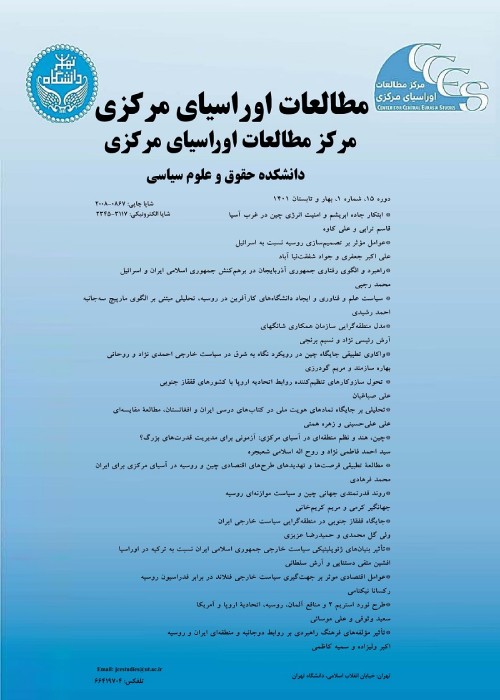A Comparative Study on the Cultural Diplomacy of Iran and Saudi Arabia in Central Asia
Author(s):
Article Type:
Research/Original Article (دارای رتبه معتبر)
Abstract:
The present study compares the soft power and cultural presence of Iran and Saudi Arabia in Central Asia and the cultural activities of both countries in this region after the collapse of the Soviet Union. The research seeks to answer the main question: “How successful has Iranian cultural diplomacy been in Central Asia compared to Saudi Arabia’s cultural diplomacy in the region?” the research also seeks to make comparisons between the two country’s diplomacy and cultural practices in Central Asia and also compare possible contradictions of these countries cultural practices. While analyzing the basic and main goals of Iranian and Saudi cultural diplomacy, the paper examines the strengths and weaknesses of the two countries’ cultural presence in the Central Asian region, the damages each country’s cultural presence impose on the other one’s interests, and possible ways to improve the quality of Iran’s cultural activities in the region. This article has been written in a descriptive-analytical method and its answer to the main question is that both Islamic Republic and Saudi Arabia have achieved some success in the field of cultural activities in Central Asia. However, given the fact that Saudi investment has increased dramatically in the region including in the cultural sector in recent years, Iran needs to pay more attention to the Central Asian region with which it has more commonalities than Saudi Arabia. This necessity is highlighted so that Iran won’t fall behind in this important regional competition. In the 21st century, the communications revolution has increased interactions among various players within the international system, making it easier and more effective to influence the public opinion of other countries. Today, public opinion has become so important and influential that governments see it as an important and effective pillar in their decisions. As a result of this increasing importance of public opinion, governments, in addition to traditional ways of communicating with other countries, also use public opinion to influence different groups of people. Countries pursue their national interests and political goals as well as the promotion of their influence among people in other countries by using new, different, and indirect methods, the most important of which are public and cultural diplomacy. Central Asia has turned into a symbolic feature of the international relations geography in the Post-Cold War era. The economic problems that the countries of the region have faced since the collapse of the Soviet Union have gradually turned into political issues. For this reason, political, economic, social, and religious ties of five Central Asian countries with other states have drawn international relations researcher’s attention. Among these, we can refer to the European Union’s special attention to the vast oil and gas reserves of Central Asian countries to provide its energy needs. Traces of Iranian, Islamic, and Chinese civilizations can be seen in Central Asia. Islam has always been part of the identity of the people of this region in a way that has played an important role in the ethnic and national unity of the people of these countries both before and after their independence. In addition to the religious commonalities, Iran has common cultural and historical backgrounds with Central Asian countries and the Caucasus, while Saudi Arabia has only the first feature which is religious similarity. According to some intellectuals, Iran’s weak cultural diplomacy and lack of access to intact opportunities have allowed Saudis to open up their place among former Soviet Muslim states and consequently influence their way of thinking. Saudi Arabia has been very active in the field of public diplomacy and cultural diplomacy in various regions including Central Asia. This aspect of Saudi diplomacy focuses on religious issues and the propagation of Wahhabism. Saudi Arabia makes the most out of the existence of the two holy shrines in its territory as well as other historical backgrounds to provide the world with its definition of religion in the form of cultural diplomacy. Economic support has also allowed the country to create various institutions and media centers to promote Wahhabism. Of course, some researchers believe that this goal will not be very successful due to the limitations and weaknesses of Wahhabi thoughts and also different weaknesses of the Saudi political system. The leaders of Saudi Arabia have always done their best, by using all their capacities to expand Salafi ideas. An example of this development is in their ongoing activities is the Muslim World League; the league is in the view of some scholars, the main arm of Saudi Arabia’s cultural diplomacy in the world. Given that the majority of Central Asians are Sunni Muslims, such activities have made some effects. Comparing cultural diplomacy of the Islamic Republic of Iran and Saudi Arabia in the Central Asian region, it should be noted that Iran pursues, in general, expansion of the Persian language and cultural symbols such as Nowruz, but Saudi Arabia tries to influence these societies through the expansion of Salafism thoughts. Saudi Arabia has addressed the expansion of Salafi thoughts in various forms. Iran’s cultural relations with Central Asia which are mainly managed by the Islamic Culture and Relations Organization have been pursued in various fields; however, the remarkable point is the inactiveness and negligence of the organization and other relevant cultural institutions toward Saudi Arabia’s activities in the region in recent years. The neglect has led to the growth of Wahhabi and Salafi ideas by the Saudi propaganda apparatus, backed by petrodollars in Central Asia. Iran’s weak cultural activities have allowed the Saudis to increase their cultural presence in the region with all their might and expand their influence in various fields. For the common cultural capacities and similarities between Iranian society and those of Central Asia, it will be possible to implement various cultural programs and compensate for the past shortcomings. This can happen if there will be regular and purposeful coordination and cooperation between responsible agencies, especially the Iran Islamic Culture and Relations Organization and the Ministry of Foreign Affairs. Taking advantage of cultural diplomats and experts, using potential capacities of ECO, effective participation in various cultural festivals, launching foreign radio and television networks between the region’s nations that have a common language, enjoying cyberspace, and planning joint academic and tourism projects can pave the way for bringing Central Asian societies closer to Iran.
Keywords:
Language:
Persian
Published:
Central Eurasia Studies, Volume:13 Issue: 27, 2021
Pages:
445 to 464
magiran.com/p2244052
دانلود و مطالعه متن این مقاله با یکی از روشهای زیر امکان پذیر است:
اشتراک شخصی
با عضویت و پرداخت آنلاین حق اشتراک یکساله به مبلغ 1,390,000ريال میتوانید 70 عنوان مطلب دانلود کنید!
اشتراک سازمانی
به کتابخانه دانشگاه یا محل کار خود پیشنهاد کنید تا اشتراک سازمانی این پایگاه را برای دسترسی نامحدود همه کاربران به متن مطالب تهیه نمایند!
توجه!
- حق عضویت دریافتی صرف حمایت از نشریات عضو و نگهداری، تکمیل و توسعه مگیران میشود.
- پرداخت حق اشتراک و دانلود مقالات اجازه بازنشر آن در سایر رسانههای چاپی و دیجیتال را به کاربر نمیدهد.
In order to view content subscription is required
Personal subscription
Subscribe magiran.com for 70 € euros via PayPal and download 70 articles during a year.
Organization subscription
Please contact us to subscribe your university or library for unlimited access!




